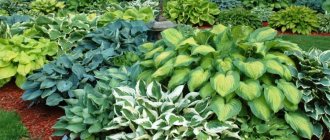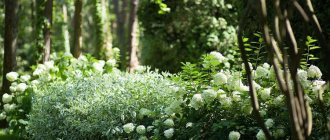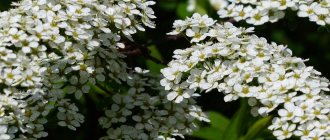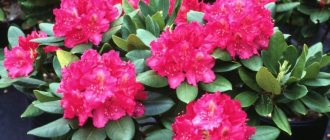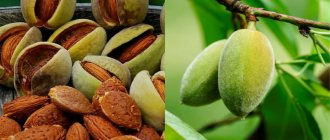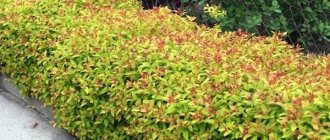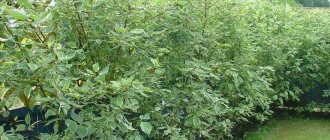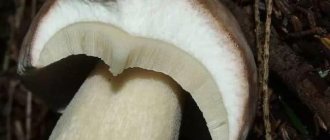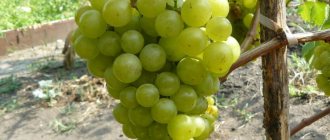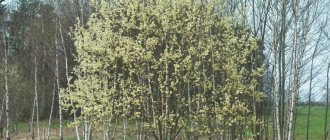6000
In parks, near roads, and in garden plots, turf is often planted. In the central regions and in the north, white Elegantissima and Siberian derain are in demand, which are more adapted to cold climates. Even a novice gardener can grow and beautifully prune an unpretentious shrub if you study the proposed instructions.
Neighborhood with hydrangea
Application in landscape
The name of the variety “Elegantissima” fully justifies itself - the plant will look noble and elegant on any site.
Its value for landscape design is due to the fact that derain is highly decorative, easy to grow, unpretentious in care, and decorates the garden plot both during the growing season and in winter. In spring, the garden landscape is enlivened by budding leaves, in summer and autumn - by lush flowering and elegant variegated foliage, and in winter, snow-white snowdrifts are decorated with expressive paintings of purple-red shoots. Using pruning, various shapes are formed from the crown of the tree - a column, a hemisphere, a ball, a cube. Experienced designers often experiment with pruning, change the shape of the bushes every year and can even create the shape of an exotic animal. The plantings look good on the site both individually and in group plantings. They are often used to create hedges or to camouflage outbuildings. An elegant and visually light Elegantissima bush can become an original decoration in front of the entrance to the house.
In combination with decorative conifers, such as juniper, or with shrubs with red leaves, designers create unique compositions from white Elegantissima wood that can arouse the admiration of the strictest connoisseur.
To learn how to properly propagate white dogwood “Elengantissima”, see the following video.
When to plant?
In late spring, summer or early autumn, you can easily plant white Elegantissima turf in a permanent place. Caring for the bush after planting is simple:
- Thoroughly compact the soil around the plant.
- Water generously and mulch the ground around the bush with sawdust, pine needles or leaves.
- If the weather is hot and sunny, then you need to shade the turf for three or four days, making sure that the soil does not dry out.
If a tree seedling is purchased with an open root system, then when you bring it home, immerse it in water for several hours, and only then plant it. If the shoots are quite large, then for better adaptation of the plant they should be cut by about 1/3.
Botanical characteristics of the plant
White dogwood Elegantissima (full name in Latin Cornus alba Elegantissima) belongs to the group of deciduous shrubs of the Dogwood family. Thanks to its high frost resistance, as noted in the description of the variety, the ornamental shrub can withstand harsh Russian winters. In the natural environment it is found mainly in Siberia and the Far East.
White dogwood Elegantissima is a deciduous shrub of the Dogwood family.
White dogwood Elegantissima is considered one of the brightest and most spectacular representatives of the Dogwood family. The average height of the bush is 3 m. The size of the crown depends on the chosen molding option, so the diameter of the bush can vary from 3 to 5 m. Most often, the plant is given a spherical or hemispherical shape.
Young shoots, which are characterized by an olive-green color, are highly flexible. The bark of mature shoots is grayish-red in color, which is why the plant is popularly nicknamed redwood. Spreading branches tend to intertwine abundantly.
Derain Elegantissima attracts attention with the unusual color of its leaves. Heart-shaped and broad-oval leaf blades are painted bluish-green with a delicate white-cream edge.
The surface of the leaf is slightly concave, length – up to 10 cm.
Blooms in May-June. Sometimes repeated flowering is possible, which occurs in the second ten days of August. The variety is characterized by corymbose-type inflorescences with small flowers of white or light pink color. At the end of the flowering period, small blue-gray fruits are formed. Derain Elegantissima berries are not suitable for human consumption.
Elegantissima has an unusual leaf color
Reproduction and planting
White Elegantissima turf is propagated by seeds, green and lignified cuttings, layering:
- The seeds are collected in the fall, after ripening. They have high germination rate. You can sow in the fall, but it is better to stratify them in a cold place (cellar, refrigerator) at a temperature of about 4 degrees Celsius. In the area where white deer bushes grow, the seeds are carried by birds, so they sprout in the most unexpected places.
- Green cuttings do not take root well. And those that do grow, some freeze out in the first winter. A significantly better result is obtained by rooting two-year-old woody cuttings. This happens because the root buds are located along the entire length of any branch. Therefore, even sticks that are used to tie other plants germinate. It is better to propagate decorative varieties of dogwood by vegetative means, because the seeds do not allow the best properties of the mother bushes to be preserved.
- The easiest way to propagate white Elegantissima turf is by layering. To do this, in the spring it is enough to dig one of the young branches to a depth of 10 cm, fix it, constantly water it or keep the soil in this place moist. Roots form in about six months. The next year or autumn, the young bush is planted in another place. Better yet, leave it for a year, form a beautiful bush, and then replant it.
White Elegantissima derain grows best in dry, sunny areas. But it does well in partial shade. It can also grow in the shade, but then the white border on the leaves becomes narrow. This slightly reduces the decorative properties of the bush. It is not afraid of underground waters that come close to the roots of the plant.
Prefers fertile and moist soils. But it can also grow on the poor. In this case, he needs feeding. It grows slowly on dry sandy loam soils and has low decorative properties. But clay soils are also not very suitable for growing turf. They are too heavy and do not allow oxygen to reach the roots of the plant. Therefore it grows slowly.
The pit for planting turf is prepared in advance, no less than 2 weeks before planting. Humus, compost, and mineral fertilizers are added. These substances will be enough so that the plant does not need feeding for several years.
White dogwood care
The care that white dogwood needs is completely simple and does not require much effort and time:
Only young seedlings, as well as adult bushes on hot, dry days, need regular watering. Seedlings are moistened every day, and adult shrubs 2-3 times a month. It is necessary to pour 2-2.5 buckets of water under each plant. There is no need to feed white turf, but if you want the shrubs to grow faster, flowering abundantly, and the foliage to acquire as many bright colors as possible, then you can fertilize the shrubs 2 times a year
This is done in the spring with mineral fertilizers (150 g for each bush), and in the summer with organic matter (5-7 kg of compost, humus or chicken manure for each bush). Well, the most pleasant and important maintenance event that the turf needs is pruning.
White tree trimming
White dogwood is remarkable because you can create real miracles with its crown. A little patience and perseverance, and your garden will be decorated with shrubs of the most unusual and intricate shapes.
So, a few recommendations to help you:
- To work you will need a garden pruner and a saw.
- Before starting to form the crown, it is necessary to trim off all diseased, frostbitten and old branches that have lost their shine.
- After this, unsightly protruding shoots that will interfere with decorative pruning are trimmed.
- It is necessary to maintain a beautiful crown shape all year round so as not to neglect it, otherwise there will be more work later. The only time when you are allowed not to prune is the winter season. But if the winter is not frosty, then a few unsightly protruding branches can be cut off.
- If you suddenly cut off more branches than necessary, do not be discouraged - the bushes quickly produce new shoots and you can always correct the situation.
Crown formation
Several options for forming the crown of the tree that will give it an elegant look:
- Column. It is most convenient to form a crown in the form of a column from a bush grown by cuttings. Trim off all protruding shoots, leaving only straight-growing shoots, which will form the column. Do not overdo it so that your bush does not look like a candle and does not fall on its side.
- Arc. You can create arches from wood formed into columns by bending the shoots towards the fence and securing them to it. Under such arches you can install benches for relaxing in the shade.
- Hemisphere. On mature shrubs, you need to cut off young 2-3 year old shoots, leaving 10-15 cm above the ground. Shrubs pruned in this way begin to grow more actively, producing many new shoots. Also, thanks to this pruning, the lower part is not exposed. Low shrubs 1-1.5 m are best suited for hemispherical formation.
- Cube, ball and other figures. Using garden shears, you can give your bushes any shape you like. And if you have design skills, then it won’t be difficult to create more complex elements - people, animals and even sea creatures. As a result, your garden will turn into an unusual area, decorated with “living” figures.
As you can see, growing white dogwood is not that difficult. This shrub deserves to have a place on your site. For this, the derain will delight you with its beauty all year round.
Caring for finicky varieties
Variegata and other white tree varieties adapt well to unfavorable conditions. Proper planting and care help improve the decorative properties of the plant.
Care instructions:
- Water throughout the growing season. 10 liters of water are poured under each bush. During the dry period, the norm is increased to 15-20 liters.
- Carry out shallow loosening and mulching of the root zone with peat or sawdust.
- Remove weeds that have grown around the bush.
Decorative mulching - Feed once every 2-3 years. If the pig is planted on poor soil, fertilizing is done twice a year: in the spring - with complex mineral fertilizer, in the summer - with organic matter. A good option is to feed the plant with wood ash annually.
- Protect young bushes from frost.
- Fight pests, gray mold and powdery mildew. Insects do not like the juice of red grass, so only aphids and scale insects attack it. Insects are destroyed using Karbofos or infusions of tobacco, potato tops, and onion peels. Effective remedies against fungal diseases are bard liquid, as well as the preparations “Hom” and “Vectra”.
How often should I prune?
They begin to radically trim the bushes at the age of three. This stage of care is especially important. Knowing how quickly turf grows, you can guess that without regular cutting it will lose its aesthetic qualities.
Video about cutting wood.
Bush pruning is done several times a year:
- In early spring, old bushes are rejuvenated. The branches on them are cut out almost completely, leaving stumps 15 cm high. During the growing season, young shoots will grow in their place.
- After the leaves bloom, remove the branches that froze in winter.
- In autumn, the branches are shortened by 2/3 to stimulate the formation of leaves and ovaries for the next year. If you plan to decorate your winter landscape, autumn pruning is not performed.
In autumn, branches are shortened by 2/3 - At any time (except for the moment of active sap flow) for crown formation.
general description
Very often, people call these shrubs white dogwood or white dogwood. And in Western countries and the United States, derain is called a dog tree. Most likely, the shrub received this name due to its fruits, which look very similar to wolfberries. For a very long time, the wood of this bush was used to make daggers and knives.
White dogwood belongs to the dogwood family. The shrub is also a species that can live well in Russia, as it adapts well to harsh winters. White derain is a fairly large crop. It has flexible spreading branches. The color of the bark can be red or red-brown. In its natural habitat, white turf can be found on roadsides, on the banks of reservoirs, and also on forest edges.
This unusual plant literally looks beautiful all year round. By the end of summer, fruits of a round shape and white color ripen on the bush. The diameter of one fruit is about 8 mm. At the same time, small white flowers are formed and collected in inflorescences. In autumn, the foliage of the shrub is decorative. It is painted in burgundy, orange and crimson shades. Even against the backdrop of white snow in winter, this shrub looks very impressive thanks to its red bark.
Breeding rules
To propagate shrubs, you can use seeds, cuttings and layering. All of these types of breeding can be practiced, but with varying effectiveness.
Seeds
Ripe seeds are collected in the fall. Their germination can last up to 5 years, but to get a good result it is better to take fresh ones and carry out stratification. To do this, you need to place the seeds in a moistened mixture of sawdust, moss and peat and keep them for 3-4 months at a temperature of 4-5°C. At home, a container with planting material can be placed in the refrigerator in the vegetable compartment. You can also entrust the stratification of seeds to Mother Nature by planting them directly into the ground before winter.
When propagated by seeds, plants develop very slowly and reach the parameters of an adult bush only 8-10 years after planting. This is the most labor-intensive method of propagation. It takes too long before young bushes are planted in a permanent place, so this method is almost never used in practice.
Cuttings
Cuttings for planting should be prepared in the summer, at the end of June or at the beginning of July. Flexible shoots with mature wood, with at least two internodes, are suitable for this. The selected branches must be cleared of the lower leaves, and the upper ones should be cut in half. To form roots, the cuttings are placed in water for about 7-9 days. The water level should be slightly above the lower internodes. When small roots grow a little (up to about 1 cm), the branches are planted in the ground until spring, preferably in a small greenhouse
It is important to know that when planted with green cuttings, plants take root with difficulty and may freeze in winter.
Two-year-old mature cuttings with lignified bark are much hardier than green ones. They take root well, as they have root buds along their entire length. In the spring you need to choose a good strong bush, cut a shoot from it and bend it a little to check its suitability. An unusable cutting will not fully straighten or even break.
A temporary planting site is prepared for the selected cuttings; these are boxes with nutritious soil made from sand and humus. Before planting, the soil is slightly moistened, the cuttings are buried in the ground at an angle of 45 degrees. For the normal development of planting material, the soil is regularly sprayed, avoiding waterlogging. It is advisable to maintain the temperature regime at 20-35°C; for this, boxes with plantings are placed in a greenhouse. In autumn, the cuttings are completely ready for planting in a permanent place.
By layering
Reproduction by layering is the most optimal option for the Elegantissima variety. To do this in the spring, you need to bend one young branch from an adult bush to the soil from the lowest shoots, dig it into the ground about 10 cm and secure it with a metal “pin” or just wire. An indispensable condition for the successful formation of roots on layering is constant moisture in the place where the branch is buried, so regular and timely watering is necessary. The root system of the layering should be completely formed by autumn. The young bush can be transplanted from the mother bush in the same fall, but experts recommend it is better to do this in the spring, when the cuttings are well established.
How does white turf propagate?
Cornus alba can be propagated in different ways:
- cuttings;
- layering;
- dividing the bush;
- seeds.
The best planting material is lignified branches of two-year-old adult plants that have 2 internodes. Green cuttings, even if they take root, often die in the first winter.
- Propagation of dogwood by cuttings
Growing shrubs by cuttings
In the spring, during pruning, the tops with buds are cut off from the branches and placed in moist soil or in a container with water. Before carrying out planting work, the leaves are removed from the bottom of the workpiece. The cuttings are planted in the ground at an angle, having first spilled the holes with water. Dusting the lower cuts with Kornevin helps accelerate root formation. Plantings are covered with film or plastic bottles. Until rooting, the soil is kept moist; the film is not removed. After 2 weeks, young plants take root.
It is more convenient to plant the preparations in separate pots, as it simplifies the transfer to wintering and subsequent planting to a permanent place of residence.
Video with the rules for successful cuttings.
- Reproduction by layering
In the spring, a young shoot is selected from the plant and buried to a depth of 8-10 cm. During the season, the soil in this place is systematically watered. The young shrub is transplanted to a new location in the fall, next spring, or a year later, when the shrub gets stronger.
- Dividing the bush
You need to plant white turf using this method as follows:
- In early spring or autumn, dig a shallow hole.
- Young shoots with roots are separated from the adult mother bush.
- Place the planting material in the hole, without deepening the root collar more than 2-3 cm.
After planting, the young bush is immediately watered.
- Propagation of derain by seeds
This method is used less frequently, since the process is lengthy and requires painstaking work. Although the shrub grows more hardy than its counterparts.
Growing from seeds
You need to proceed as follows:
- Seeds are selected from ripened fruits and stored at room temperature.
- Before planting, the seeds are placed in the refrigerator for stratification.
- Garden soil, sand, peat and sawdust are combined in a container. Then the seeds are mixed into the composition (proportion 3:1).
- In early spring, seeds are sown in furrows 5 cm deep.
It is rational to plant turf in this way only if there is no other material. Despite the fact that the seeds germinate well, you will have to wait 2 years for sprouts.
Planting and care
You can plant turf in spring or autumn. In colder regions, spring planting is preferable so that the plant has time to get stronger before the onset of cold weather. The site for planting the white elegantissima tree should be prepared in advance, approximately two weeks in advance. If you plan to plant several bushes nearby, then you need to leave at least one and a half meters between the planting holes.
The process of planting tree elegantissima can be described as follows:
- You need to dig a planting hole, focusing on the size of the seedling's earthen ball.
- The soil removed from the pit is well loosened and enriched with nutrients - compost, peat, leaf soil or humus. In addition, complex mineral fertilizers must be added to the soil.
- The hole is filled with prepared soil and left for two weeks. In a similar way, you can prepare a planting site in the fall for planting dogwood in the spring.
- After two weeks, the hole is dug again, a layer of drainage is placed at the bottom, on which compost or humus is additionally poured, covered with earth approximately halfway and watered well.
- When the water is absorbed, a seedling is placed on top along with a lump of earth. If you purchased planting material with an open root system, then you need to lower it into the hole and carefully straighten the roots.
- The hole with the seedling is carefully filled with the remaining soil, compacted and well moistened.
Further care of the plant is not at all difficult. The soil around the bush needs to be mulched to prevent the root system from drying out and the appearance of weeds.
During the season, you will need to carefully loosen the soil to allow the roots to breathe, as well as regularly remove weeds. In the future, the bush will grow and suppress the development of weeds around it
Regular watering is not required; it only needs moisture from the soil and precipitation. Only in dry periods with a lack of moisture should you water the plant, using 1-2 buckets for each bush.
Once every 3-4 years it will be necessary to feed the turf with humus, as well as complex mineral fertilizers. Every spring and autumn, it is advisable to sprinkle the soil around the bush with wood ash.
White dogwood, where to buy, terms and rules of planting
You can purchase the plant directly from the nursery or order it online. The last option is quite common, it is only important to check the sites before ordering so as not to stumble upon scammers.
The timing of disembarkation depends on how exactly the seating takes place. So, freshly collected seeds can be sown in the fall, and purchased planting material - in the spring. In addition, cuttings are planted in the spring.
In autumn, seedlings are also planted by layering.
It is important not to be late. It is recommended to plant before the first frost. Deren must have time to settle into his new place.
After purchasing, it is important to plant the shrub correctly, which is not so difficult even for an inexperienced gardener.
Derain is quite hardy, however, it is worth paying attention to proper planting:
- When selecting a site, it is recommended to give preference to well-lit open areas. Elegantissima should not be planted in shaded areas, as lack of light greatly inhibits growth. In this case, the foliage narrows significantly and the lush shrub as a result becomes too inconspicuous. If there is absolutely no way out, you can stop in partial shade;
- The optimal soil will be slightly moist and fertile. However, it can also exist on poor soils, if you do not forget about the systematic application of fertilizers;
- It is optimal to transplant the acquired elegantissima by transshipment together with an earthen lump. This will help protect it from damage and reduce stress;
- It is important to provide the plant with a drainage system, and cover the top layer with a layer of mulch after planting. This will help retain moisture in the soil and protect the young seedling from weeds.
A properly prepared site and soil are the key to lush growth and flowering of the shrub.
Following simple rules will help you avoid many care problems in the future.
White dogwood diseases
Adult plants are very rarely exposed to various diseases, but as for young bushes, they are often attacked by a scourge such as powdery mildew. This disease of all garden plants and flowers is classified as a type of fungal infection that is caused by microspores of fungal colonies.
Infections most often appear first on the lower leaves and shoots, then move up the plant. The disease spoils the appearance of the white tree and one has to forget about its beautiful appearance. Infection occurs in early spring, when spores begin to be released from plant debris used by the fungus for wintering.
A whitish coating appears on the leaves; with further development, drops of liquid appear on the surface, hence the name of the fungus “powdery mildew.” Brownish balls are visible on the shoots and trunk. With further disease, the colony of fungi lives by feeding on the juices of the plant and gradually kills it. The bush does not bloom, the foliage is faded and gradually dries out and falls off.
Conditions conducive to fungal infections are dry seasons coupled with sudden temperature changes. Sometimes the disease can be provoked by excessive fertilizing with nitrogen fertilizers. Pruning a bush at the root is useful in terms of increasing the mass of shoots, but it significantly weakens the plant and makes it vulnerable.
The fight against powdery mildew involves some preventive measures
- Derain bushes should be planted at a distance of up to two meters from each other so that the roots have space to develop.
- The root system is thinned out in spring and autumn for best growth and to avoid infection.
- Watering flowers is carried out at the root; watering from above provokes disease.
- Be sure to thoroughly remove any remaining vegetation from the flowerbed in the fall so that there is no room for the mushrooms to overwinter.
- To stop the spread of a slightly infected bush, all diseased branches are removed from it. Using them for compost is strictly prohibited.
Treatment of affected flowers is carried out using traditional methods in the form of spraying with various disinfecting decoctions. Brew three tablespoons of garlic in a bucket of water, cool and use undiluted to spray on bushes. A decoction of horsetail fights powdery mildew no less effectively. A solution of soda ash and soap in water is suitable for the same purposes.
Differences between white Sibirika Variegata and Elegantissima
The varieties of white wood Elegantissima and Sibirika Variegata are similar in many ways, but there are also a number of significant differences between them:
- The Sibirika Variegata variety is slightly lower - the height of an adult plant is only 2 m, while the Elegantissima variety reaches 3 m in height after 10 years.
- The diameter of the plant is also smaller - about 2 m.
- The leaf color is dark green. The foliage of the white Elegantissima variety is lighter.
- The surface of the leaf blade of the Sibirika Variegata variety is often covered with cream-colored spots or stripes.
- In autumn, the leaves of the Sibirika Variegata tree acquire a pinkish-purple hue. White Derain Elegantissima does not change its color.
- The flowers of the Elegantissima variety are white. The Sibirika Variegata variety has cream flowers with a greenish tint.
- Sibirika Variegata grows more slowly than its counterpart and does not form shoots as actively.
- Derain Elegantissima bears fruit abundantly with proper care. The Sibirika Variegata variety bears fruit more modestly.
Derain white
The most common in our region is white dogwood (Cornus alba). It is a deciduous shrub growing up to three meters. Its upward-pointing straight branches have a reddish color of various shades. Young shoots often have a slight bluish coating. The green leaves are oval-shaped, pointed upward, slightly wrinkled. May have a whitish edge. The length of the leaf plate is about ten centimeters. It blooms twice a year: the first time in early summer, and the second in the first half of autumn. Small white or slightly pink flowers are united in a corymb inflorescence. At the end of summer, inedible round fruits, drupes, blue-white or yellowish in color, ripen.
White dogwood is represented in ornamental gardening in many varieties.
Let's pay attention to just a few of them
Spaethii is a very common species; it has a golden-yellow border along the edge of the leaf in combination with the same spots and stripes. In autumn the foliage turns purple. The shoots are red-brown. Doesn't bloom.
White dogwood “Shpeta”
- Aurea, or Golden, with yellow and yellow-green foliage and red shoots. Winter hardiness is average.
- Elegantissima is the most frost-resistant, distinguished by a bright and wide white border, as well as red branches.
White Derain "Elegantissima"
- Siberian or Sibirica (Sibirica) - the height of the bush is one and a half meters, it has a very beautiful red tint of the branches. The leaves are green, turning yellow and red in autumn.
- Sibirica Variegata - variegated form (up to 2 m), foliage with a white border and spots; in autumn the green part of the leaf becomes brownish-purple. The shoots are bright red.
White dogwood "Sibirika variegata"
White Derain "Kesselring"
- Kesselringii is an unusually beautiful chameleon bush. The leaves are purple-brown when they bloom, then turn greenish-brown and turn bronze in autumn. The fruits are white and the shoots are black and red.
- Cream Cracker is one of the new varieties, low (about 1 m), with red shoots, the leaves have a yellowish border, which gradually becomes creamy.
There are many other varieties of white turf, all of which are distinguished by good frost resistance. Representatives of this species bloom after two years of life.
Short description
Derain Elegantissima is a deciduous shrub belonging to the Dogwood family. It got its name for the elegant appearance of the crown and the variegated color of the foliage. This decorative form is most often used in landscape design of plots, gardens, and urban landscaping, as it looks advantageous in any composition.
Derain Elegantissima is a deciduous shrub of the Dogwood family.
The plant has very thin and flexible shoots, intensively branching and stretching upward. Without regular pruning, it can reach a height of 3 m, growing 4–5 m wide. The color of the shoots is brown, becoming rich red closer to autumn, thanks to which the bush continues to decorate the garden even in winter. A special feature of the variety are large heart-shaped leaves of a grayish-green color with white or cream strokes and an openwork edging along the edge.
The first flowering of the shrub occurs at the age of three. Subsequently, it blooms twice a year - in early summer and in September, forming dense inflorescences consisting of many small white flowers. After flowering, fruits are formed on the shoots - round berries with a diameter of about 8 mm. They ripen just in time for September, when the bush blooms again, which gives it additional decorativeness.
The fruits of the plant - small yellowish-white drupes - are inedible and are not used for food.
Main characteristics of white dogwood
White turf is a deciduous shrub with charming colors of each individual variety. The plant belongs to the dogwood family. The bush is quite unpretentious, but looks impressive. Kazakhstan and Siberia are considered to be the birthplace of krasnotal. In addition to its main name, the people called deren by other names - svidina, dogwood, redwood. In the old days, craftsmen made canes, knives and even daggers from wood of the tree.
easy to prune, frost resistant
Appearance.
- The branches are brown and brown in color. The wood is elastic and durable. In a young bush, the color of the bark has a coral tint, but at an older age the color changes to brown.
- The inflorescences are formed into an “umbrella” and are painted white with a purple tint at the tips. The bush blooms 2 times a year, the beginning and end of summer.
- After the flowering period, stone fruits of a bluish or white-turquoise hue are formed from the ovaries.
- The leaves are spreading and wide. They reach a size of up to 10 cm. The color is light green at the edges and dark green in the middle.
- The height of the bush is relatively large. Dogwood can reach up to three meters in length.
- Life expectancy is 20−25 years.
Features of Elegantissima turf care
Despite the fact that Elegantissima is an unpretentious and persistent plant, a couple of points should not be forgotten.
With proper watering, fertilizing and pruning, the turf will not remain in debt and will reward you with lush color and rapid growth.
Watering
There is no need to water elegantissima often, however, you should not allow the soil to dry out. The optimal dose is two buckets of water per bush, the frequency of watering is 2 times a month.
Watering should only be done in the evening or in the morning, before or after the heat begins. If the weather forecast promises a too hot day, you should avoid watering altogether, which can lead to burns on the foliage.
Feeding
Frequent feeding for the variety is also not necessary, since the shrub does not need a large amount of fertilizer. A layer of nutritious soil mixture, which was placed at the bottom of the hole two weeks before planting, is enough. This fertilizer will be enough for two to three years.
Adding humus to a young seedling will be beneficial.
Additional feeding is necessary only in case of improper pruning or disease that negatively affects the condition of the plant.
Repeated complex mineral feeding should be carried out after three years. At the same time, the bush does not need a large amount of organic matter; you can fertilize the soil under the bush with peat in July, but this is not at all necessary.
Derain Elegantissima in landscape design
The leading characteristics of the Elegantissima white tree variety are the unpretentiousness of this garden crop and the high degree of decorativeness, which is ensured by the bright color of young branches and the unusual color of the leaves. These qualities have earned the shrub great popularity in the field of landscape design - derain is used both in single plantings and in group compositions. A special advantage is the ease of forming the crown of the plant.
Advice! White Elegantissima derain looks very beautiful near a group of birches or trees with an openwork type of crown.
How to form a tree from Elegantissima wood
The decorative quality of the Elegantissima tree is quickly lost in the absence of periodic pruning. In order to maintain the attractive appearance of the bush, it is necessary to pinch it with your hands or trim the shoots with garden shears.
Since the variety is capable of growing strongly in the shortest possible time, the shrub can be formed into almost any shape:
To give the tree the appearance of a column, it is necessary to remove first of all the side shoots. Central strong branches leave
It is important not to make the column too narrow - if you remove too many branches, the plant may fall under the influence of strong winds. The formation of an arch from Elegantissima wood is very popular. To do this, the bush is attached to a special arched structure, tying the ends of the shoots to it. Hemisphere - another popular figure made of wood
This form is formed by pruning one-year and three-year-old branches in autumn or spring at a level of 10 cm from ground level. As a result, active growth of young shoots begins. In this way, the plant is also rejuvenated and made more decorative, since young shoots have a rich red tint.
White Elegantissima wood also forms full-fledged balls and cubes. The variety of shapes is almost unlimited, and every subsequent year you can try new shapes - this does not harm the bush in any way.
Elegantissima tree hedge
Forming a hedge from the white Elegantissima variety of wood is impossible without timely pruning. The shrub quickly forms new shoots, and if they are not removed, the plantings will become overgrown.
In order to maintain the decorative appearance of a turf fence, it is necessary to regularly remove shoots that are too prominent and dried out or broken throughout the year. Deeper pruning is carried out in August or September.
Cuttings or layering?
The easiest way to propagate derain is through root layering. This procedure can be carried out at any warm time of the year by simply bending the lowest-lying shoot to the soil, securing it with a wire or metal “pin,” and then covering it with earth. In about six months, a good root system will form, and you can separate the rooted cuttings with pruners and transplant them to a permanent place.
Cuttings of white dogwood are carried out only in the summer months, cutting off mature two-year growths, since green young shoots take root very poorly. Prepared cuttings are recommended to be planted in special seedling beds or greenhouses. When preparing holes, it is important to make drainage to drain water. For the winter, the rooted cuttings are transplanted into pots or boxes and transferred to the basement, and in the spring they are planted in open ground.
White dogwood variety
The plant has more than 20 species. Varieties grow throughout almost the entire territory of our country. The following varieties of white turf can often be found in the form of hedges in landscape design and are popular:
- Elegantissima. It withstands cold well, grows up to 2.5 - 3 meters. Its leaves are bluish-green with a white rim along the edge, which acquires a pinkish tint with the arrival of autumn.
- Siberia. Reaches 1.5 meters, is distinguished by lush green foliage and coral shoots, which look especially interesting in winter, contrasting with the whiteness of the snow. The fruits are white with a soft blue tint. Siberian derain looks good in a hedge.
- Sibirika Variegata. It grows up to 2 meters, the crown is formed from light green leaves bordered with a white rim; with the arrival of autumn they turn brownish-purple. It does not bloom very luxuriantly, forming greenish-cream colored inflorescences. This is an excellent option for growing in cold climates as the plant is frost-hardy. Also, Sibirika Variegata fits well into small areas due to its small size.
- Aurea. Reaches a height of 2 meters. The variety has the largest leaves among its fellows. In spring, brown-burgundy leaves appear from the buds, which over time acquire a delicate yellowish color. Blooms with light cream inflorescences.
- Shpeta. It grows with a spreading crown, reaching 2.5 meters in height. The shoots of the red bush stand straight, the green foliage has golden stripes and the same border. The color does not change throughout the year, giving the impression of a golden speck when viewed from afar.
- Ivory Hal. The shrub stretches tall with straight red-brown shoots and can grow up to 2 meters. The foliage is green with white veins and has the same edging, which turns red-brown in color by autumn. When flowering it forms yellow inflorescences. It grows quickly, but little growth is produced when compared with the elegantissima variety.
- Guhalti. This deciduous shrub reaches 2-3 meters. The shoots are twig-shaped with a bright red color, the foliage is green with yellow edged with pink, the fruits are white and blue.
- Cream cracker. The height can vary from 80 cm to 3 meters, it depends on the growing conditions. The purple-red branches stand straight and are located freely. The leaves are light green in color and have creamy stripes and edges. Young shoots are distinguished by bright golden leaves. Cream flowers are collected in corymic inflorescences; small white fruits appear in August.
Use in garden design
Fences are formed from bushes. But you need to remember that if you stop trimming the formed hedge, it will quickly lose its decorative appearance. An impenetrable thicket forms in place of the fence. With the help of beautifully trimmed turf bushes, you can decorate an unsightly building or hide an unsightly shed. It is also often used to create a color scheme in the garden or to create a light background. It takes root perfectly in city squares, combined with thickets of barberry, weigela or juniper. Near Elegantissima, perennial flowers are often planted, the foliage of which has a reddish or purple tint. Such combinations give the flower garden a special elegance and unusual beauty.
Tree trimming
The shrub needs regular pruning once it reaches three years of age. Its mechanism is quite simple: first, they get rid of old, weak and diseased stems, then cut out shoots that extend far beyond the boundaries of the bush.
A similar event is repeated annually in spring and autumn, this will help provoke the active growth of fresh shoots and their branching at the base of the bush. If you neglect pruning, then gradually it will become bare from below and will no longer be so attractive.
Trees with bright bark are pruned every couple of years, but always in early spring before the buds swell. In this case, all shoots of the bush are shortened, leaving no more than 20 cm from the soil level. Thanks to this, the plant forms many young bright shoots, the length of which reaches half a meter.
You can renew old or refresh overgrown bushes by completely pruning them at the root. This procedure is carried out every few years, the turf takes it easily and soon restores its previous size.
